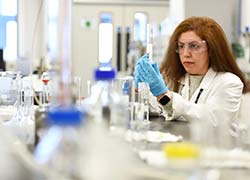Tackling the Metatarsal scourge of England’s footballers
As England prepare to resume their World Cup qualifying campaign, a sports scientist here believes he can come up with a method of preventing – or reducing the incidence of – that most fashionable of football injuries, the fractured metatarsal.
It is a mishap which entered the national consciousness when David Beckham was hurt shortly before the 2002 World Cup and embedded itself firmly when Wayne Rooney was similarly afflicted in the run-up to the 2006 tournament.
Reader in biomechanics at Teesside And as England players, fans and the coach Fabio Capello keep their fingers crossed about an injury free build up to Saturday’s Wembley clash, Iain Spears, Reader in Biomechanics at the University and a prolific inventor, says he may be on the way to finding an answer to the metatarsal scourge of our Premiership stars.
Spears, an avid England supporter, explains there are five metatarsals among the small bones which make up the complex mechanism of the human foot and different groups of sportsmen are particularly prone to specific fractures
Footballers – and American footballers as well – suffer particularly from injuries to the fifth one. As it happens neither Beckham’s nor Rooney’s was a fifth metatarsal break, which may be why they both recovered more quickly than was initially forecast. One reason why a fifth metatarsal fracture, which is what Emile Heskey had for instance, is particularly feared by footballers is that it can take a long time to heal, Spears explains.
‘We don’t really know what causes metatarsal fractures, but they appear to be overuse injuries which occur more frequently towards the end of the season’.
Suspicions focus on football boots As Spears seeks an explanation, his suspicions focus on football boots – and in particular the way that modern players regard them. ‘I have talked to Middlesbrough’s physio. He tells me that many Premiership players wear new boots for every match. The manufacturers want to see their boots looking good and their logos as clear as possible on television and some players say that new boots give them a better touch and feel for the ball.’
It is a very different attitude to the amateur footballer, for whom boots are an annual – or still less frequent – purchase to be treated with care and conserved for as long as possible.
Spears has teamed up with other researchers to create simulations of the impact on the foot of different types of boot. ‘We can look to see, for instance, whether wearing boots that are too tight creates greater stress on the metatarsal. We’ll look at the differences in the stiffness of the sole or of the material making up the outside of the boot. It may be that modern lightweight materials, though advantageous in other ways, make players more vulnerable. Another possibility is that you can reduce pressure by changing the alignment of the studs.’
Spears is in the process of applying for research funding for a project not only to increase understanding of the human body and its fragilities but also to look at the significant implications for such a high-profile industry.
 Supporting Nigerian farmers by transforming food waste into
...
Supporting Nigerian farmers by transforming food waste into
... International partnership signed with prestigious American
...
International partnership signed with prestigious American
... Teesside University academics join prestigious network of
...
Teesside University academics join prestigious network of
...